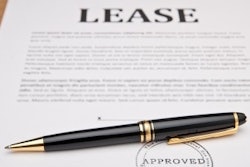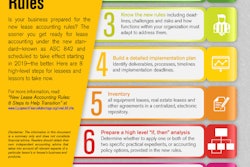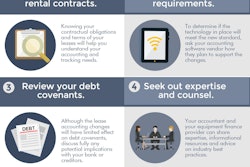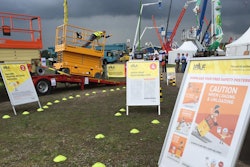
New accounting rules — just what you needed. But there is nothing you can do about them if you have annual financial statements prepared by a CPA firm. One good point is that they do not take effect until 2019, giving you time to review the new rules and prepare your internal accounting department to properly record both existing leases (where applicable) and future leases starting in 2019.
So what changes? Currently, lease payments for other than sales-type leases are expensed on the income statement. Sales-type leases should be recorded like a purchase where you book the asset as well as a corresponding liability, and depreciate the asset and amortize the liability with the monthly payment. While operating leases only hit the income statement, they are summarized monetarily for five years in the company footnotes. In other words, if someone wants to know what your total fixed commitments are, they can review both the footnote regarding bank debt and the footnote regarding leases.
Starting in 2019, nearly all leases will appear on your balance sheet. In addition to the sales-type leases, it will add two items regarding operating leases to the balance sheet in the form of a Right to Use asset and a corresponding Lease Liability, both of which are amortized over the term of the lease. Existing operating leases as of December 31, 2018, will also have to be converted to the new standards for the remaining payments on those leases.
The reason for the changes is to put companies that purchase equipment on the same footing as those that lease equipment using operating leases.
It’s not very complicated. You add up your total lease payments, which equal your Right to Use asset, and do the same for the Lease Liability. Then you amortize both on a straight-line basis over the life of the lease. In most cases, the lease payment you would have used for an operating lease and the amortized amount under the new method should be the same.
Leases with maintenance contracts included will need to be bifurcated between lease payment and maintenance payment, with the lessee having the option to include the maintenance portion in the Right to Use asset or to expense it as it is paid. A benefit of bifurcating a lease payment is that the lessee will know the “real” cost of the maintenance.
Short-term leases fall outside of these new requirements. Short-term leases are leases less than a year. But if you are thinking you can just string together two or three years of one-year leases using the same equipment, forget about it.
So as it stands, you will now have an asset and a liability on our books that you have not had before; the same monthly payment as you had as an operating lease being used to reduce the liability; and a new Lease Liability charge hitting the income statement for the same amount of the lease payment.
The reason for the changes is to put companies that purchase equipment on the same footing as those that lease equipment using operating leases. This means zero impact on those that purchase assets and maybe a problem for those that currently lease.
Insight on Impact of Changes
So is an increase in assets with a corresponding increase in liabilities a problem? In my mind, both “yes” and “maybe.” Yes, because it will reduce your return on assets, and maybe, if your banks consider the Lease Liability a dumb-liability not used to calculate both the Debt/Equity ratio and your Debt/Coverage ratio. But who knows how a banker or finance company will look at it? It’s possible that, even if they don’t include the Lease Liability in the debt-related covenants, they might look at your company a different way once they see how your lease liabilities impact its viability. I would.
To give you some insight into the impact of the two operating lease factors involved, take a look at the “Profit Planning Model” below and spend a few minutes contemplating how the new rules will affect your business. It would be a good idea to prepare year-end results with and without the new lease transactions so that you can compare results with prior years.
Using the model shown above, Path 1 will generate the same result with an operating lease or amortization of a Right to Use asset.
Path 2 will be lower because assets increased while net sales did not. Return on assets (ROA) will also be lower because asset balance is higher.
Path 3 will be higher with the Lease Liability included, but not if the dumb Lease Liability is eliminated before the calculation is made. With the Lease Liability included, financial leverage increases.
Return on equity (ROE) doesn’t change because net income doesn’t change, and adding both an asset and liability means equity doesn’t change.
In the end the changes between an operating lease using the former method and the new method is an increase in assets (lower ROA) and an increase in liabilities (which may be eliminated before calculating debt covenants). ROE, Debt/Equity, Net Worth and EBITDA Margin do not change. As mentioned previously, however, having more information in front of a lender, or in front of an OEM or other readers of your financial statements, could result in a negative impression compared to what it was before you made these changes.
Consequently, here are some items to ponder:
- You may want to segregate out any maintenance agreements to reduce the size of “lease” entries you need to make.
- You may want to enter shorter contracts to reduce the amount of the lease transaction.
- Your normal equipment rental transactions should not impact these changes.
But you can’t let the accounting or tax tail wag the dog — unless you are very highly leveraged when you add in the leases. If so, you may want to hold off on any further commitments until you reduce your leverage percentage to industry standards.
This is a simple version of what will take place. I assure you, the accounting staff will pull their hair out when they have to implement the change. Thus, I suggest you get started figuring out what to do sooner than later. I would also suggest you work with lessors and have them prepare a summary of how you should record the transaction. At least it will be a good place to start.


















